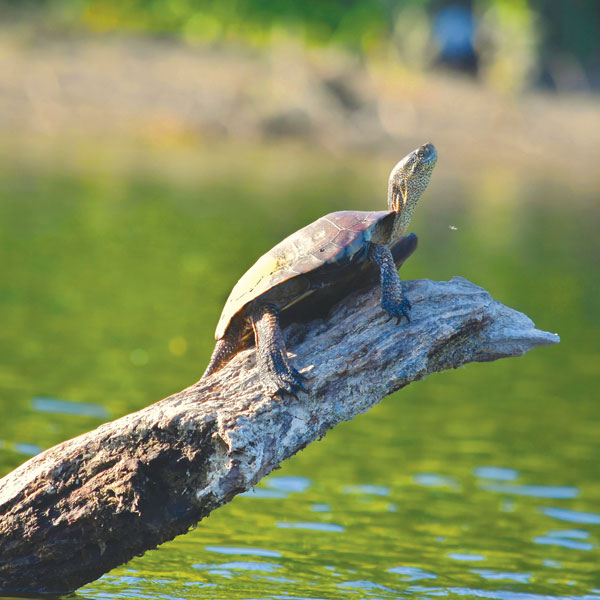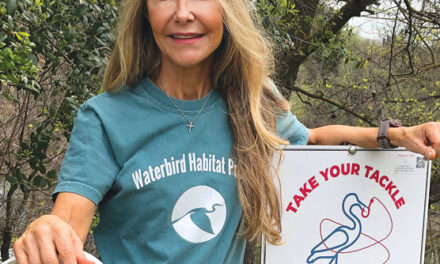The slightest noise—heavy footstep, rustling branch, loud whisper—will send the northwestern pond turtle off a sunlit log and into his safe place, the cool waters of the American River.
He’s a shy creature. The booming sounds of heavy machinery tearing up his riparian habitat will not bode well for him.
Next summer, the U.S. Army Corps of Engineers will begin another phase of its erosion-control project along the lower American River from the Howe Avenue bridge to east of Watt Avenue.
Trucks, tractors and excavators will bulldoze through the wild and scenic parkway landscape.
Just in time for northwestern pond turtle nesting season.

The turtles mate throughout spring and summer. Females lay eggs on land, sometimes as far as 500 feet from water. They pack soil and vegetation over the eggs, making nests almost impossible to detect.
“If construction begins, the turtles’ dirt-covered nests will be in the path of destruction,” says Dr. Michelle Stevens, professor of environmental studies at Sacramento State University.
The hatchlings remain in their terrestrial nests over winter. When they emerge in spring, they are the size of a quarter. Their shell is soft. “Those hatchlings are trying to make their way to the water. So that’s also a risky time for them,” says Sac State grad student and senior research assistant Lexi von Ehrenkrook.
Stevens and von Ehrenkrook’s comment letter to the Army Corps notes hatchlings are sensitive to disturbances. They are at risk of falling into construction excavations and being crushed by equipment.
The Army Corps reports, “Unfortunately, wildlife is often displaced as a result of vegetation removal in advance of construction activities.” The Corps says those activities are timed for fall and early winter, “typically the non-breeding season, when the level of impact/displacement to wildlife would be minimal.”
Fall through winter is when the adult turtle metabolism slows (called brumation). They burrow in mud, close to water’s edge, making the reptile difficult to detect.
“Turtles are cold-blooded animals,” says Professor Stevens, who heads up a restoration project at Bushy Lake, habitat to hundreds of turtles on the American River near Cal Expo. “If the turtles are in a state of dormancy, any in the riverbanks or river’s edge would be squashed.”
To avoid conflicts with heavy equipment, the comment letter recommends an on-site monitor during construction, and stopping work during turtle brumation and nesting.
Steven’s team recommends fencing around the construction area for a year to keep turtles out and prevent nesting.
Does the Army Corps have plans for fencing? “Oh, heck no,” Stevens says.
Last month, Stevens and her team began nest surveys to determine how many northwestern pond turtles will be affected by the erosion-control work.
“You need to know the site and know how different species are using the area,” von Ehrenkrook says. “If there is an important site they return to and that’s suddenly gone, what are they going to do? Having information and surveying is critical.”
Stevens calls the Army Corps’ Environmental Impact Report convoluted, confusing and difficult to analyze. “It was remiss in its investigation and consideration of the impact on wildlife, and in particular the turtles.”
The Army Corps says wildlife will “move to adjacent habitats upstream and downstream of the construction footprint.” It says the displacement will be temporary.
“We have such a truncated, fragmented corridor for wildlife habitat anyway,” Stevens says. “It’s been disturbed and destroyed by wildfire, homeless encampments. We have so little left.
“Where do they think they’ll go?”
To mitigate the impact, the Army Corps reports “two to three times the amount of habitat will be replaced and protected.”
“How can they possibly say that?” Stevens asks. “Are they going to use a magic wand and take out all the houses? The animals are just going to move up and down the river? I think not.”
For now, the turtles’ fate is in the hands of the U.S. Fish and Wildlife Service. Last September, the federal agency proposed listing the northwestern pond turtle and southwestern pond turtle as threatened species under the Endangered Species Act.
The Fish and Wildlife Service cites habitat loss and fragmentation, drought and predation by invasive species. The turtles have an “increased risk of extinction.”
An endangered listing would provide immediate protection for the turtles. Conservation efforts include enhancing, protecting and restoring pond turtle habitat—the opposite of the Army Corps’ erosion-control plan.
Under the ESA, actions by federal agencies—such as the Army Corps of Engineers—cannot impair essential behavior patterns, including breeding, feeding and sheltering.
Status of listing the western pond turtle as threatened is pending. “It’s a lengthy process. But if they do get listed, it’s going to be a game changer,” Stevens says.
“Food, water and shelter for northwestern pond turtles and southwestern pond turtles are becoming scarce across the western United States,” says Paul Souza, director of the U.S. Fish and Wildlife Service’s Pacific Southwest Region.
Souza says, “We need everyone’s support to help them thrive in the wild.”
Did Fish and Wildlife forget to tell the Army Corps?
Cathryn Rakich can be reached at crakich@surewest.net. Follow us on Facebook and Instagram: @insidesacramento.















